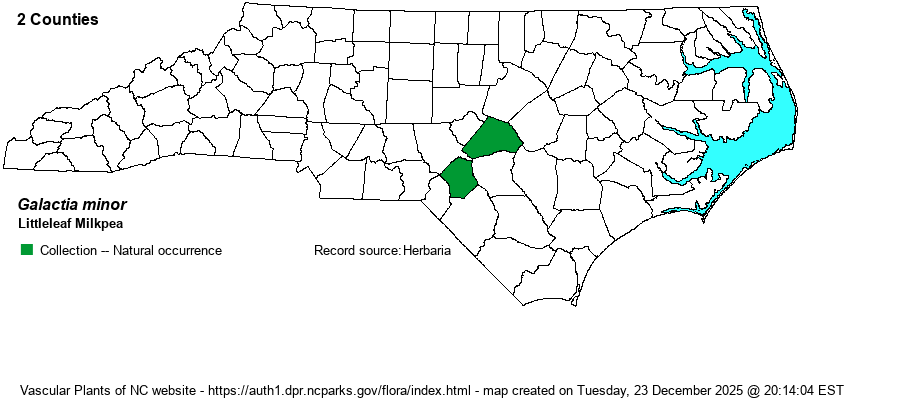| Author | W.H. Duncan | |
| Distribution | This entity was described as new in 1977 by Wilbur Duncan (journal Phytologia), but has been overlooked or included as part of the former Galactia "regularis" (now G. brachypoda). Thus, it is not well-known in NC. The species is, as far as is known, limited in NC to the inner Coastal Plain. The only two records known to the editors, so far, are from the Sandhills -- Harnett and Hoke counties -- but it likely occurs in other Sandhills counties.
Weakley (2018) states that it is found from "Sc. [south-central] NC south to Panhandle FL, west to s. MS." | |
| Abundance | Weakley (2024) has it shown as "rare" in NC on his map, limited in the state to the Coastal Plain. The NCNHP has this species on its Watch List, but as W1 (Rare but relatively secure). Bruce Sorrie checked all NCU specimens of "regularis" and "volubilis" and found no specimens of minor other than in Hoke and Harnett counties. It is so poorly known that the W7 (Poorly known in NC) is justified. The NCNHP has a Global Rank of G4, yet NatureServe Explorer (+ BONAP) does not list the species under this name, but as G. microphylla (G4). The editors suggest a State Rank of S1? for now, as the current S2? might not be warranted from such few records. | |
| Habitat | "Longleaf pine sandhills", according to Weakley (2024). | |
| Phenology | Blooms from June to August (-October); fruits from July to October. | |
| Identification | Nesom (2015) says "Galactia minor is a distinct species with procumbent, atrorosely strigulose stems, small, congested leaves with glabrous adaxial surfaces and raised venation, few flowers on a short inflorescence axis, and relatively large corollas". In Weakley's (2018) key to the genus, G. brachypoda and G. minor are separated from G. regularis and G. volubilis by the stems "procumbent at least proximally and variously twining, weakly twining, or not twining near the tip"; the other two species have stems that are climbing or sprawling and are twining. His key says that G. minor has "Internodes only a little longer to usually shorter than the largest leaflet of adjacent nodes; … leaflets (4-) 7-10 (-18) mm wide; flowers solitary and axillary or 2-4 [flowers]". On the other hand, G. brachypoda has "Several to most internodes (especially those toward the base) longer than the largest leaflet of adjacent nodes; .. leaflets (4-) 10-25 (-32) mm wide; flowers (3-) 5-15 (-25), rarely 1-2 [flowers]" (Weakley 2018). In summary, look for a non-twining, non-climbing Galactia with small leaflets that are congested on the stem, and very few (usually 1-2) "large" flowers per inflorescence. | |
| Taxonomic Comments | Few references treat this species at all, perhaps because it has not been critically studied by many botanists. BONAP uses the name G. microphylla, which is thought to be a synonym (more research needed).
| |
| Other Common Name(s) | Little Milkpea | |
| State Rank | S2? [S1?] | |
| Global Rank | G4 | |
| State Status | W1 [W7] | |
| US Status | | |
| USACE-agcp | | |
| USACE-emp | | |

